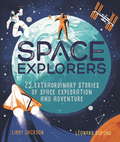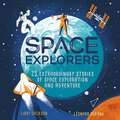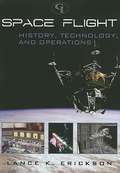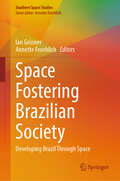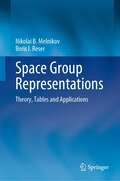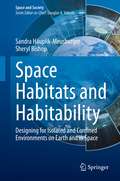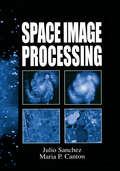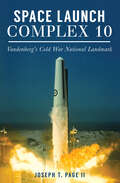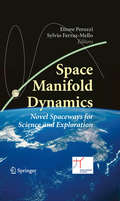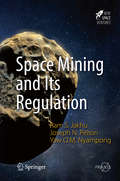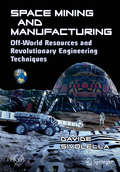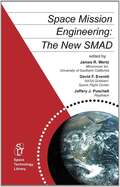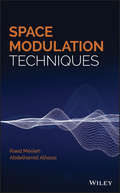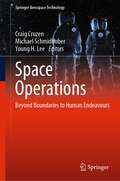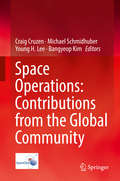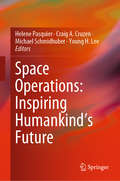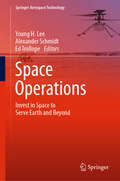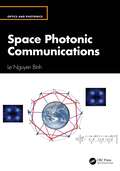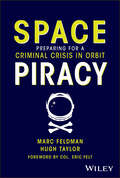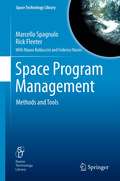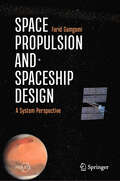- Table View
- List View
Space Explorers: 25 extraordinary stories of space exploration and adventure
by Libby JacksonA collection of amazing real-life stories about space exploration and adventure.Do you know the true story of ...*The first astronauts to land on the moon and were nearly stranded there for ever, if it hadn't been for a felt tip pen that saved them?*The 'human computers' that launched NASA's first rockets into space?*The astronaut that trained to go to space by living in underground caves and completing underwater missions?Humans have always been fascinated by the universe, but only a few have been daring enough to travel beyond the Earth.From venturing into space for the first time to building the International Space Station in orbit, the history of space exploration is filled with peril, bravery and strokes of genius.In this beautifully illustrated anthology, spaceflight expert, Libby Jackson, reveals the very best true stories of humankind's thrilling journey to the stars.Grab your space suit and jump aboard - it's time for an astronomical adventure!
Space Explorers: 25 extraordinary stories of space exploration and adventure
by Libby JacksonA collection of amazing real-life stories about space exploration and adventure.Do you know the true story of ...*The first astronauts to land on the moon and were nearly stranded there for ever, if it hadn't been for a felt tip pen that saved them?*The 'human computers' that launched NASA's first rockets into space?*The astronaut that trained to go to space by living in underground caves and completing underwater missions?Humans have always been fascinated by the universe, but only a few have been daring enough to travel beyond the Earth.From venturing into space for the first time to building the International Space Station in orbit, the history of space exploration is filled with peril, bravery and strokes of genius.In this beautifully illustrated anthology, spaceflight expert, Libby Jackson, reveals the very best true stories of humankind's thrilling journey to the stars.Grab your space suit and jump aboard - it's time for an astronomical adventure! (P)2021 Hodder & Stoughton Limited
Space Flight: History, Technology, and Operations
by Lance K. EricksonThis book is about the history of space exploration and includes an interesting presentation on the manned space program beginning with the early missions of both the US and the Soviet Union. Military space missions also receive extensive treatment.
Space Fostering Brazilian Society: Developing Brazil Through Space (Southern Space Studies)
by Annette Froehlich Ian GrosnerThis peer-reviewed book provides a comprehensive overview of the role of space exploration and technology in Brazil. The Brazilian space sector is currently experiencing rapid growth, with new participants entering the field and space applications increasingly supporting the country's social, economic, and political development. There is a growing recognition of space as a vital component of Brazil's development agenda. Despite significant progress in recent years that has improved the living conditions of many Brazilians and helped lift people out of poverty, much work remains to be done to meet the basic needs of all citizens and ensure they receive the respect they deserve. Space technology is already being utilized in various sectors to help achieve Brazil's future objectives, and there are still ample opportunities to expand the use of space systems and data. The book will be of interest to researchers, professionals, and students in fields such as space studies, international relations, governance, and social and rural development.
Space Fostering Latin American Societies: Developing the Latin American Continent through Space, Part 1 (Southern Space Studies)
by Annette FroehlichThis book presents a comprehensive overview of the role space is playing in unlocking Latin America’s developmental aspirations. It explains how space and its applications can be used to support the development of the full range and diversity of Latin American societies, while being driven by Latin American goals. The Latin American space sector is currently undergoing a phase of rapid and dynamic expansion, with new actors entering the field and with space applications increasingly used to support the continent’s social, economic, and political development. All across Latin America, attention is shifting to space as a fundamental part of the continental development agenda, and the creation of a Latin American space agency is evidence of this. Additionally, while in recent years, great advances in economic and social development have lifted many of Latin America’s people out of poverty, there is still much that needs to be done to fulfill the basic needs of the population and to afford them the dignity they deserve. To this end, space is already being employed in diverse fields of human endeavor to serve Latin America’s goals for its future, but there is still a need for further incorporation of space systems and data. The book is of great interest to researchers, professionals and students in fields such as Space Studies, International Relations, Governance, Social and Rural Development, and many others.
Space Group Representations: Theory, Tables and Applications
by Nikolai B. Melnikov Boris I. ReserThis book is devoted to the construction of space group representations, their tabulation, and illustration of their use. Representation theory of space groups has a wide range of applications in modern physics and chemistry, including studies of electron and phonon spectra, structural and magnetic phase transitions, spectroscopy, neutron scattering, and superconductivity. The book presents a clear and practical method of deducing the matrices of all irreducible representations, including double-valued, and tabulates the matrices of irreducible projective representations for all 32 crystallographic point groups. One obtains the irreducible representations of all 230 space groups by multiplying the matrices presented in these compact and convenient to use tables by easily computed factors. A number of applications to the electronic band structure calculations are illustrated through real-life examples of different crystal structures. The book's content is accessible to both graduate and advanced undergraduate students with elementary knowledge of group theory and is useful to a wide range of experimentalists and theorists in materials and solid-state physics.
Space Habitats and Habitability: Designing for Isolated and Confined Environments on Earth and in Space (Space and Society)
by Sandra Häuplik-Meusburger Sheryl BishopThis book explores creative solutions to the unique challenges inherent in crafting livable spaces in extra-terrestrial environments. The goal is to foster a constructive dialogue between the researchers and planners of future (space) habitats. The authors explore the diverse concepts of the term Habitability from the perspectives of the inhabitants as well as the planners and social sciences.The book provides an overview of the evolution and advancements of designed living spaces for manned space craft, as well as analogue research and simulation facilities in extreme environments on Earth. It highlights how various current and future concepts of Habitability have been translated into design and which ones are still missing. The main emphasis of this book is to identify the important factors that will provide for well-being in our future space environments and promote creative solutions to achieving living spaces where humans can thrive. Selected aspects are discussed from a socio-spatial professional background and possible applications are illustrated.Human factors and habitability design are important topics for all working and living spaces. For space exploration, they are vital. While human factors and certain habitability issues have been integrated into the design process of manned spacecraft, there is a crucial need to move from mere survivability to factors that support thriving. As of today, the risk of an incompatible vehicle or habitat design has already been identified by NASA as recognized key risk to human health and performance in space. Habitability and human factors will become even more important determinants for the design of future long-term and commercial space facilities as larger and more diverse groups occupy off-earth habitats. The book will not only benefit individuals and organizations responsible for manned space missions and mission simulators, but also provides relevant information to designers of terrestrial austere environments (e.g., remote operational and research facilities, hospitals, prisons, manufacturing). In addition it presents general insights on the socio-spatial relationship which is of interest to researchers of social sciences, engineers and architects.
Space Hostages
by Sophia McdougallFrom bestselling UK author Sophia McDougall comes Space Hostages, an intergalactic quest full of humor, adventure, and, of course, aliens! This hilarious middle grade sequel to Mars Evacuees is perfect for fans of Artemis Fowl and packed with nonstop fun.Young Alice Dare is relieved that at last humans and the alien Morrors are now living peacefully together on Earth. But with an influx of too many Morrors, space is getting a bit tight. To make room for all the Morrors, they've been terraforming a cold little moon in the Alpha Centauri system--and Alice and her friends are invited to the inauguration of the Morrors' new home!But just as they're approaching Alpha Centauri, the kids are kidnapped by the hostile Krakkiluks and must save themselves--and the Eemala people in the process!
Space Image Processing
by Julio SanchezSpace Image Processing covers the design and coding of PC software for processing and manipulating imagery obtained by satellites and other spacecraft. Although the contents relate to several scientific and technological fields, it serves as a programming book, providing readers with essential technical information for developing PC applications. The material focuses on images of the planet and other celestial bodies obtained by orbiting and non-orbiting spacecraft. This book is not about raster graphics in general, but about raster graphics processing as it applies to space imagery. Three parts divide the text: 1. Science - background at an introductory level - scientific principles underlying space imagery and its processing - topics related to space and remote sensing. 2. Technology - topics related to space imagery - geodesy, cartography, image data formats, image processing. 3. Programming - code examples for DOS and Windows programming on the PC - consideration of low-level and C++ code - routines with a tutorial and demonstrative purpose.
Space Launch Complex 10: Vandenberg's Cold War National Landmark (Landmarks)
by Joseph T Page IIInside the historic Cold War landmark at Vandenberg Space Force base—its technology, its people, and its military importance. Includes photos. Situated in the sand dunes of California&’s Central Coast, Space Launch Complex Ten, often called SLC-10 or &“Slick Ten,&” is a National Historic Landmark that commemorates a powerful Cold War legacy. Home to Vandenberg&’s Space and Missile Technology Center, or SAMTEC, the facility contains the rich technological heritage of the U.S. Air Force&’s space and missile launch systems. As the only remaining Thor intermediate-range ballistic missile launch site in the world, SLC-10&’s noteworthy achievements span the globe. The complex trained British Royal Air Force missileers for Project EMILY, assisted during nuclear atmospheric tests in the Pacific, and launched military weather satellites in support of the covert National Reconnaissance Program. Former air force space and missile officer Joseph T. Page II recounts amazing stories of dedicated men and women who led the American military effort to explore space.
Space Manifold Dynamics
by Sylvio Ferraz-Mello Ettore PerozziThe term "Space Manifold Dynamics" (SMD) was proposed during the workshop "Novel Spaceways for Scientific and Exploration Missions" for describing new types of spacecraft trajectories that could revolutionize how space missions are designed. Obtained by applying the dynamical system approach to mission design, these trajectories represent a fascinating alternative to elliptic motion and provide a deeper understanding of the classical three and N-body problems in celestial mechanics. This book gives a state-of-the-art overview of this new field of study together with applications of an interdisciplinary nature involving planetary science, astrophysics and the manned exploration of the solar system.
Space Mining and Its Regulation
by Joseph N. Pelton Ram S. Jakhu Yaw Otu Mankata NyampongThis book reviews the current and possible future regulatory oversight of the state and non-state actors now engaged in or planning to become engaged in the exploration and possible exploitation of space related natural resources, whether they be liquid, gaseous, or mineral. An increasing number of countries are also becoming involved in space-related activities that were previously carried out primarily by the US and the USSR (now the Russian Federation). The European Union and its individual member states, Japan, China and India in particular are assuming increasingly important roles in space as in many other areas. Even the United Arab Emirates has announced plans to send a future robotic mission to Mars. As such, exploration, exploitation and utilization of space natural resources are no longer matters to be considered within the exclusive domain of competition and decision-making between the US and the Russian Federation. It is significant to note that, in addition to this new international context, the exploitation of space natural resources is also no longer confined to the traditional domains of science and technology. Regulatory issues abound. These endeavors and how they might be regulated by international treaties, standards, codes of conduct or other means have become a truly international political issue. As a consequence, topics dealing with common concerns - sharing of resources, environment protection, and pollution - easily raise difficulties, as they require different states to agree on common principles having a direct impact on their sovereignty and financial interests. There is yet another new paradigm in the conduct of space activities. While in the past, space activities traditionally fell under the exclusive domain of governmental entities, the last few years have seen the emergence of the private sector of "space entrepreneurs". This poses several challenges for the pre-existing governance regime whose foundations are steeped in the classical State-based conception of international law. As a result, the text examines adequacies and ambiguities in treaty provisions and national laws, currently accepted practices involving the exploration and exploitation of space natural resources that will grow in importance in the coming decades.
Space Mining and Manufacturing: Off-World Resources and Revolutionary Engineering Techniques (Springer Praxis Books)
by Davide SivolellaThis book produces convincing evidence that exploiting the potential of space could help solve many environmental and social issues affecting our planet, such as pollution, overcrowding, resource depletion and conflicts, economic inequality, social unrest, economic instability and unemployment. It also touches on the legal problems that will be encountered with the implementation of the new technologies and new laws that will need to be enacted and new organizations that will need to be formed to deal with these changes.This proposition for a space economy is not science fiction, but well within the remit of current or under development technologies. Numerous technologies are described and put together to form a coherent and feasible road map that, if implemented, could lead humankind towards a brighter future.
Space Mission Engineering: The New Smad
by James Richard Wertz David F. Everett Jeffery John PuschellSpace Mission Engineering:The New SMAD is an entirely new approach to creating both a text and a practical engineering reference for space mission design. Just as space technology has advanced, the way we learn and work has changed dramatically in recent years. SME combines the best features of a traditional unified text and reference covering the entire field, an electronic version that does many of the calculations for you, and the web that allows regular updates and references to the vast literature base available online. Among the many features of this new approach are: Completely rewritten, updated, and expanded follow-on to the 3rd edition of Space Mission Analysis and Design, the most widely used text and reference in astronautics, covering a great many topics not previously covered, such as CubeSats, Inflatable Structures, Space Economics, End-of-Mission options, Space System Risk Analysis, and new, much more precise formulas for ground station and target coverage. Downloadable electronic spreadsheets for most of the numerical tables and plots in the book that let you, for example, calculate all of the critical parameters for orbits about the Sun, Moon, Earth, and any of the other planets, or even new planets, moons, or stars of your choosing. An annotated bibliography and references on the web that is updated as new references become available and that shows you where to get nearly all of the references with direct links for those available at no cost and where on the web to buy copyright books and professional papers not available for free. All of the cross referencing, careful definitions, and thoroughly explained equations that are the key ingredient of any high quality engineering text or reference, along with the wisdom and experience gained at substantial cost by some of most experienced and knowledgeable space system engineers in the world.
Space Modulation Techniques
by Raed Mesleh Abdelhamid AlhassiExplores the fundamentals required to understand, analyze, and implement space modulation techniques (SMTs) in coherent and non-coherent radio frequency environments This book focuses on the concept of space modulation techniques (SMTs), and covers those emerging high data rate wireless communication techniques. The book discusses the advantages and disadvantages of SMTs along with their performance. A general framework for analyzing the performance of SMTs is provided and used to detail their performance over several generalized fading channels. The book also addresses the transmitter design of these techniques with the optimum number of hardware components and the use of these techniques in cooperative and mm-Wave communications. Beginning with an introduction to the subject and a brief history, Space Modulation Techniques goes on to offer chapters covering MIMO systems like spatial multiplexing and space-time coding. It then looks at channel models, such as Rayleigh, Rician, Nakagami-m, and other generalized distributions. A discussion of SMTs includes techniques like space shift keying (SSK), space-time shift keying (STSK), trellis coded spatial modulation (TCSM), spatial modulation (SM), generalized spatial modulation (GSM), quadrature spatial modulation (QSM), and more. The book also presents a non-coherent design for different SMTs, and a framework for SMTs’ performance analysis in different channel conditions and in the presence of channel imperfections, all that along with an information theoretic treatment of SMTs. Lastly, it provides performance comparisons, results, and MATLAB codes and offers readers practical implementation designs for SMTs. The book also: Provides readers with the expertise of the inventors of space modulation techniques (SMTs) Analyzes error performance, capacity performance, and system complexity. Discusses practical implementation of SMTs and studies SMTs with cooperative and mm-Wave communications Explores and compares MIMO schemes Space Modulation Techniques is an ideal book for professional and academic readers that are active in the field of SMT MIMO systems.
Space Operations: Beyond Boundaries to Human Endeavours (Springer Aerospace Technology)
by Michael Schmidhuber Craig Cruzen Young H. LeeThis book includes a selection of reviewed and enhanced contributions presented at the SpaceOps 2021, the 16th International Conference on Space Operations, held virtually in May 2021. The chapter selections were made based upon their relevance to the current space operations community. The contributions represent a cross-section of three main subject areas: Mission Management – management tasks for designing, preparing and operating a particular mission; Spacecraft Operations – preparation and implementation of all activities to operate a space vehicle (crewed and uncrewed) under all conditions; and Ground Operations – preparation, qualification, and operations of a mission dedicated ground segment and appropriate infrastructure including antennas, control centers, and communication means and interfaces. The book promotes the SpaceOps Committee’s mission to foster the technical interchange on all aspects of space mission operations and ground data systems while promoting and maintaining an international community of space operations experts.
Space Operations: Contributions from the Global Community
by Michael Schmidhuber Craig Cruzen Young H. Lee Bangyeop KimThis book includes a selection of 30 reviewed and enhanced manuscripts published during the 14th SpaceOps Conference held in May 2016 in Daejeon, South Korea. The selection was driven by their quality and relevance to the space operations community. The papers represent a cross-section of three main subject areas: #65533; Mission Management - management tasks for designing, preparing and operating a particular mission. #65533; Spacecraft Operations - preparation and implementation of all activities to operate a space vehicle (crewed and uncrewed) under all conditions. #65533; Ground Operations - preparation, qualification, and operations of a mission dedicated ground segment and appropriate infrastructure including antennas, control centers, and communication means and interfaces. This book promotes the SpaceOps Committee's mission to foster the technical interchange on all aspects of space mission operations and ground data systems while promoting and maintaining an international community of space operations experts.
Space Operations: Inspiring Humankind's Future
by Michael Schmidhuber Young H. Lee Helene Pasquier Craig A. CruzenThis book includes a selection of 30 reviewed and enhanced manuscripts published during the 15th SpaceOps Conference held in May 2018 in Marseille, France. The selection was driven by their quality and relevance to the space operations community. The papers represent a cross-section of three main subject areas: Mission Management – management tasks for designing, preparing and operating a particular mission Spacecraft Operations – preparation and implementation of all activities to operate a space vehicle (crewed and uncrewed) under all conditions Ground Operations – preparation, qualification, and operations of a mission dedicated ground segment and appropriate infrastructure including antennas, control centers, and communication means and interfaces This book promotes the SpaceOps Committee’s mission to foster the technical interchange on all aspects of space mission operations and ground data systems while promoting and maintaining an international community of space operations experts.
Space Operations: Invest in Space to Serve Earth and Beyond (Springer Aerospace Technology)
by Alexander Schmidt Young H. Lee Ed TrollopeThis book includes a carefully curated selection of contributions that were presented at the 17th International Conference on Space Operations (SpaceOps) held in Dubai, UAE, from March 6th to 10th, 2023. The selection of chapters was based on their relevance to the current space operations community. The contributions represent a cross-section of three main subject areas: Mission Management—management tasks for designing, preparing and operating a particular mission; Spacecraft Operations—preparation and implementation of all activities to operate a space vehicle (crewed and uncrewed) under all conditions; and Ground Operations—preparation, qualification, and operations of a mission dedicated ground segment and infrastructure, including antennas, control centers, and communication means and interfaces. The book highlights the SpaceOps Committee’s objective to encourage the exchange of technical knowledge regarding space mission operations and ground data systems. Additionally, it emphasizes the significance of establishing and sustaining a global community of experts in space operations.
Space Optical Remote Sensing: Fundamentals and System Design (Advances in Optics and Optoelectronics)
by Jiasheng TaoThis book highlights the fundamentals, technologies, and methods of space optical remote sensing and system design. The author introduces concepts and methods established during his decades of research and practice, covering topics such as difference between the spatial resolution of pixel and the resolution of traditional film, the resolution of remote sensing image for characteristics and target recognition purpose, and image shift problem of sampling image space. The book comprehensively and systematically introduces the basic concepts, theories, parameter design calculations of imaging cameras, multispectral cameras, surveying cameras, infrared cameras, and imaging spectrometers, their respective system components, and performance evaluation of space optical remote sensing systems. The book also discusses the overall design of space optical remote sensing systems, including light sources, the ground-air system, target characteristics, spectrum selection, energy calculation, orbital parameters, optical remote sensor parameters, spacecraft parameters coordination and selection, comprehensive analysis, and large-scale system performance evaluation methods, forming a complete idea on how to achieve the goals of the system design. The book enables readers to understand the working principles of the whole systems from a theoretical depth and grasp the full skillset on how to implement advantages and balance technical difficulties for orbit, subsystems of the platform, and payloads. The book is a must-read for those who seek to build strong ability for research, development, and innovation surrounding the subject matter.
Space Photonic Communications (Optics and Photonics)
by Le Nguyen BinhThis book explores the extension of fiber optic communications technology to space optical communications. It presents the specific demands for space communications and examines propagation in a vacuum and also over the turbulence of air‑free space.Space Photonic Communications begins with historical aspects of optical communications in both terrestrial and inter‑satellite constellations. It presents the advances in optical communications and integrated photonics that have enabled the technological developments for space photonic communications, especially coherent optical communications to transport Tbps information. The author discusses how the transmission of massive amounts of data over very long distances requires Tera‑bps communications in real time for both military and civil applications. The author also explores laser communications with the physics of laser propagation over ultra‑long distances without optical amplifications at intermediate locations. He also examines modulation and receiving techniques for space photonic communications.Intended for communications engineers and professionals, especially those in laser communication technologies, this book could also be used in courses on advanced optical communications, photonic communications, and communication techniques and technologies.
Space Piracy: Preparing for a Criminal Crisis in Orbit
by Hugh Taylor Marc FeldmanComprehensive exploration of humanity's potential for criminal activities in outer space Space Piracy: Preparing for a Criminal Crisis in Orbit is a forward-thinking resource that considers, analyzes, and provides solutions to the influence of the ignoble side of humanity in the realm of outer space, where potential for crime, corruption, piracy, and war increases as the exploitation of space as a commercial resource continues to develop. This book blends the authors' knowledge with that of subject matter experts to deliver a holistic understanding of criminality in space and help readers broaden their horizons beyond their own area of specialization. Some of the topics explored in this insightful book include: Space hacking, from software, data, network, and hardware risks to existing cybersecurity standards and practices in space Criminal organizations that might pursue criminal activities in space, including cartels, kidnappers and devicenappers, and governments Laws and treaties relevant to space crime, such as the Communications Satellite Act and the Outer Space Treaty of 1967 Filled with practical, thought-provoking knowledge and guidance, Space Piracy: Preparing for a Criminal Crisis in Orbit earns a well-deserved spot on the bookshelves of professionals working in the best of humanity's institutions, including law and intelligence services, finance, insurance and risk management, corporations, and the sciences, who seek to combat what the worst of us may be dreaming up.
Space Policy for the Twenty-First Century
by Wendy N. Whitman Cobb Derrick V. FrazierA foundational, accessible overview of space policy in the United States This book provides readers with the first comprehensive overview of major space policies in the United States and a framework through which to analyze them. It examines all facets of space policy—civilian, military, and commercial—and presents this material accessibly for use by readers at multiple levels, from undergraduate courses to government practitioners making and implementing policy. The first section offers a history of space exploration, focusing on the US within a global context. The second section looks at the actors and institutions involved in setting space policy in a government based on the separation of powers, including the president, Congress, NASA, and the Department of Defense. The book concludes with chapters on the different sectors of space policy, as well as questions this field will face in the future. As policymakers and business leaders become increasingly aware of the everyday systems that depend on space technologies, such as communications, mapping, and weather monitoring, and as space becomes a more visible arena for commercial competition, potential humanitarian gain, and military threats, Space Policy for the Twenty-First Century helps students and professionals navigate the complexity of space as a policy area.
Space Program Management
by Marcello Spagnulo Federico Nasini Mauro Balduccini Rick FleeterBeginning with the basic elements that differentiate space programs from other management challenges, Space Program Management explains through theory and example of real programs from around the world, the philosophical and technical tools needed to successfully manage large, technically complex space programs both in the government and commercial environment. Chapters address both systems and configuration management, the management of risk, estimation, measurement and control of both funding and the program schedule, and the structure of the aerospace industry worldwide.
Space Propulsion and Spaceship Design: A System Perspective (Springer Praxis Books)
by Farid GamgamiThe objective of this textbook is to provide a synopsis of propulsion technologies in the context of spaceship design. The author identified a lack of multidisciplinary textbooks that explain to students both the technology and physics of space propulsion as well as its relationship to other disciplines in the process of spaceship design. To make the subject more tangible, the propulsion demanding context of space exploration was chosen. The book therefore begins with the astronomical context relevant to human exploration of the solar system. This challenging endeavour requires powerful space propulsion systems of various types. Existing and emerging technologies are systematically discussed. Principle similarities and technological analogies between the different types are highlighted. Starting from the physical working principle, the book progressively extends the view to subsystem and system design aspects. This approach recognises that the propulsion subsystem is the most defining architectural element of large spacecraft, i.e. starships. Such a comprehensive presentation of propulsion technology from a system perspective is not yet reflected in the existing literature. In order to apply the fundamental knowledge provided in the first 9 chapters, a mission to the dwarf planet Ceres is presented, where different propulsion technologies have to be combined to achieve the mission objectives. In this way, the reader is introduced to the basics of requirements breakdown, design space analysis and the technical trade-off process, all of which are essential for early mission planning. The book is aimed at advanced undergraduate and graduate students, recent postgraduates, and newcomers to the field of spacecraft design where propulsion is essential.
